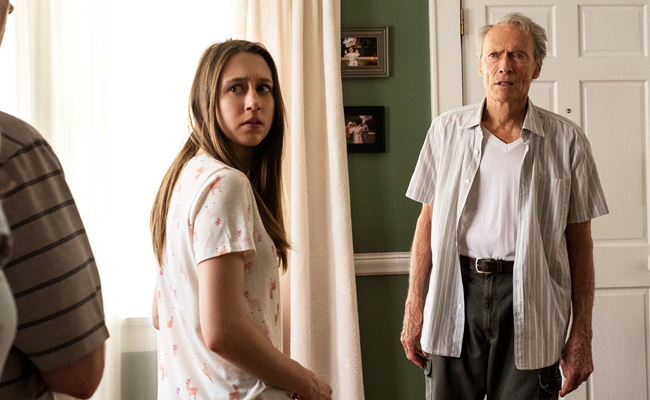
Clint Eastwood has long been notorious for rushing his actors through scenes and refusing to do second takes. In the past you might have noticed this in a few scenes, manifested in momentarily uneven acting, or say, an entire scene shot with an obviously fake baby, because Ol’ Clint refused to wait for the real one.
Fast forward to now and this tendency has evolved to the point that Eastwood’s latest movie, The Mule, feels almost entirely defined by its creator’s impatience — the cinematic equivalent of your grandpa weaving down the street hitting parked cars and garbage cans with his car while telling you to calm down because it’s fine, everything’s fine, wouldja stop worrying so damn much? The Mule has the broad strokes of a story and just sort of yadda yaddas every other detail like it’s late for supper. If the actors flub a line or a plot point seems incongruous, the movie speeds right along it like it didn’t happen. The upside is that it’s briskly paced.
Even the on-the-nose casting itself feels like the product of someone refusing to do a second draft. Michael Peña as a cop? Sure, why not? He’s the first actor you think of when you think “cop,” right? Andy Garcia as the heavy, the Mexican twins from Breaking Bad as henchmen, and Clifton Collins Jr. as the heavy’s duplicitous deputy? Of course! Hey, stop coming up with alternate suggestions, we got it, let’s shoot this thing already, time’s a-wastin’.
It should be said: this quality isn’t entirely uncharming.
Everything’s better when imbued with the personality of its creator and while Eastwood may have lost a step in terms of quality filmmaking, he’s gained one in pathos. It’s relatable too, the way he seems in a rush to get to the end of his movie.
In a throwback to Grand Torino, Eastwood has once again cast himself as the main character, Earl Stone, who has neglected his family in favor of his career, as… a horticulturalist. Not a profession I generally associate with workaholics, but sure, whatever. When the internet kills Earl’s flower business (in an early scene Earl actually walks by a guy on a computer and growls “internet!”) the bank forecloses on his Peoria farm. In an early scene, he affectionately addresses his Latino employees as “maricónes” in horribly accented Spanish (maricónes means “fagg*ts,” but to be fair it does seem to be used with insane frequency in Latin America). With his stuff packed into the bed of his pickup, Earl has a propitious meeting with a smooth-talking Latino who sends Earl down a lucrative new career path as an octogenarian drug mule (The Mule was actually based on a New York Magazine article, “The Sinaloa Cartel’s 90-Year Old Drug Mule”). Earl uses the money to win back his estranged family and save the rec center, er, the VFW hall.
The main difference between Eastwood’s character in Gran Torino and his character in The Mule is that while they’re both racist old dudes, everyone seems to adore ball-busting old Earl for some reason, no matter how many times he refers to them as “beaners,” “dykes,” or “negroes.” Which gives The Mule more pathos. The Mule is a little like The Room, not in the sense of inept filmmaking, because say what you will about Eastwood’s haste or casting choices, the man knows dramatic structure; but in the sense that both put the biases and insecurities of their creators on vivid display, in ways the creators probably didn’t even realize. Is Earl a character or Eastwood’s idealized id?
You can practically hear Eastwood growling the subtext of each scene in your ear, a running series of gripes about snowflakes, queers, and the young folk always buried in their damned phones. To be fair, when Earl meets San Francisco’s famous Dykes On Bikes in an entirely throwaway scene, he treats them with an amused sort of “live and let live” attitude. They’re essentially a prop to prove Earl’s inner tolerance, despite his vocabulary. “Tolerate” is the proper word for it. Earl can accept gays and minorities as long they can accept being called racial slurs and understand that Earl finds them exotic and strange.
Some of Eastwood’s grumbles over the modern world actually land, like the recurring theme that the world was better when it ran on handshakes and personal trust rather than automation and big data. Drug lord Andy Garcia likes Earl, who gets his job done effectively and in his own way. Garcia’s lieutenants, meanwhile, can’t stand Earl’s improvising, his stopping on his own schedule and ignoring the computer-generated routes.
The Mule, scripted by Nick Schenk (Gran Torino, The Judge) is onto something with the whole “treating people like people” thing. Yet it often devolves into old-man-yelling-at-cloud territory, like when Earl stops to help a black couple change a tire on their Prius. The man is trying to Google “how to change the tire” when Earl sidles up and growls “didn’t your father teach you anything?”
Even more cringe-worthy is a scene where a guy who gets pulled over by police keeps spouting statistics about how dangerous traffic stops are for brown people. He’s worrying over nothing, according to the film, and the subtext of the entire scene seems to be “police brutality is fake news.”
Yet there’s something cathartic about watching Eastwood lay his biases on the table, even when they’re bad. Filmmakers so rarely risk that these days. Mostly because they could never dream of the kind of privilege Clint Eastwood has, but still. You could never say The Mule is lacking in character. That character is mostly “racist uncle,” but you can’t say it’s not entertaining.
Vince Mancini is on Twitter. You can find his archive of reviews here.






